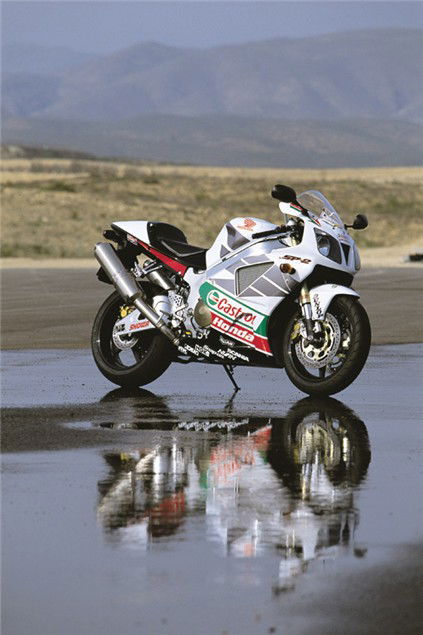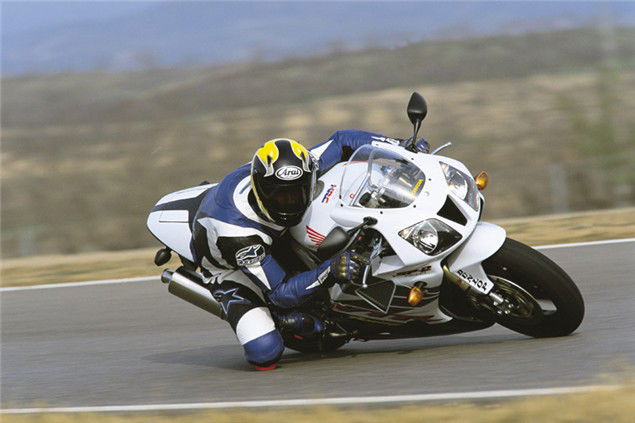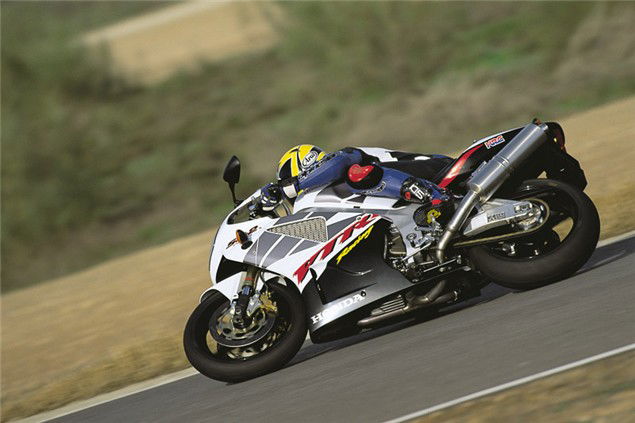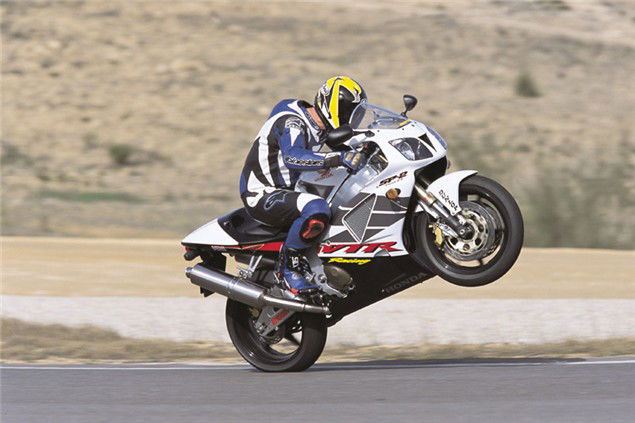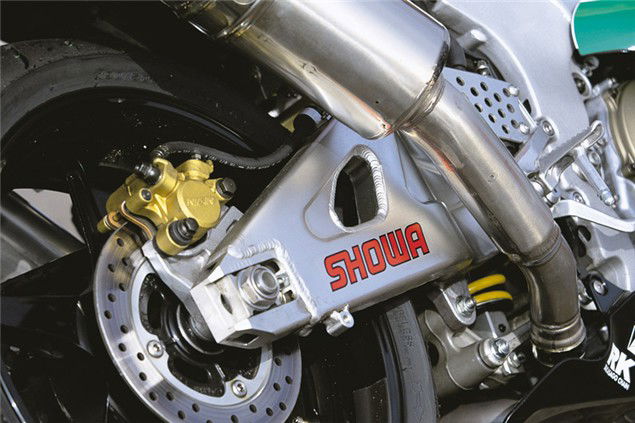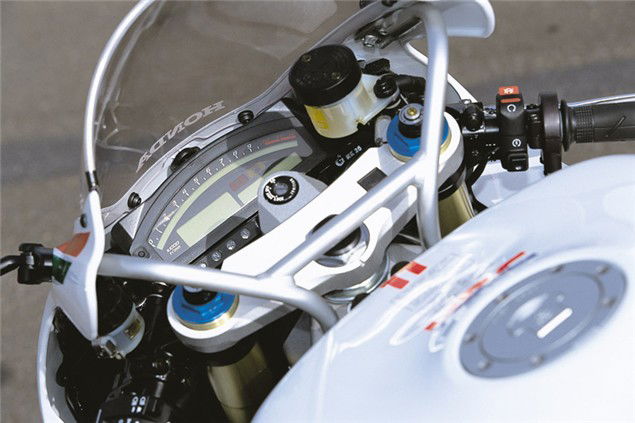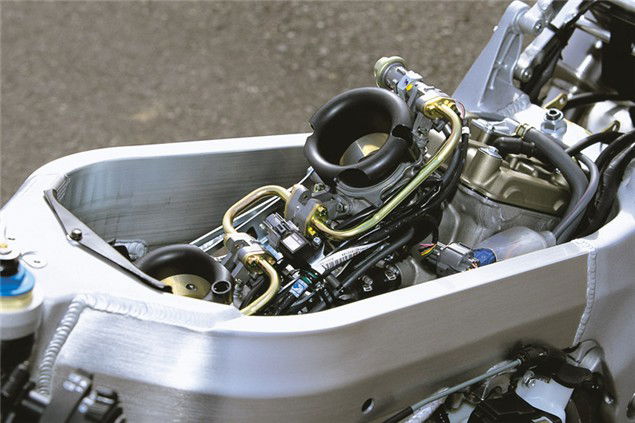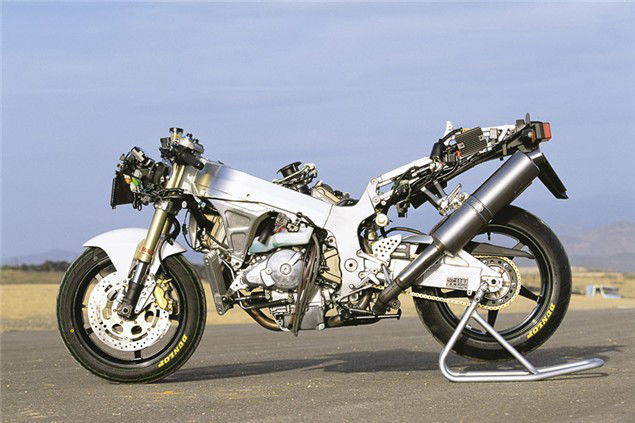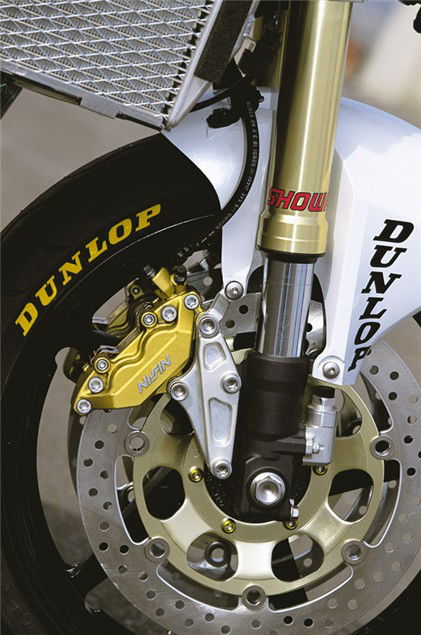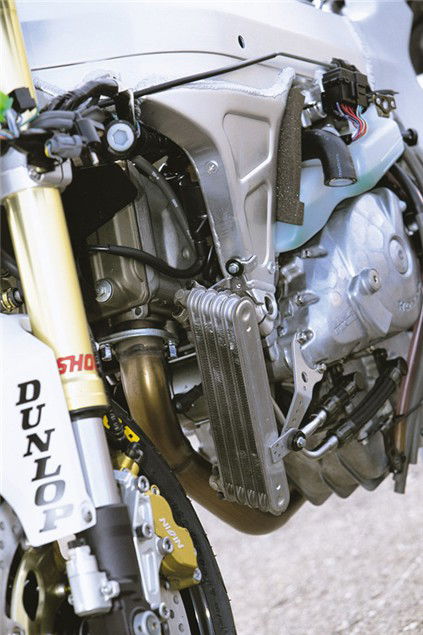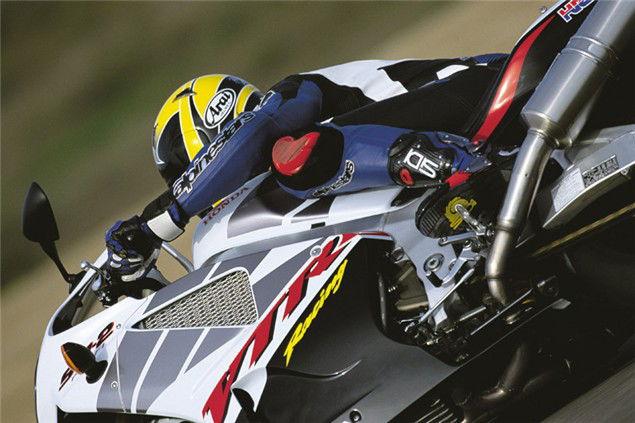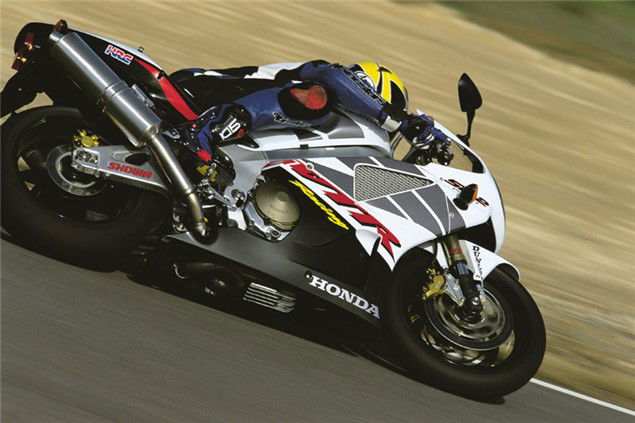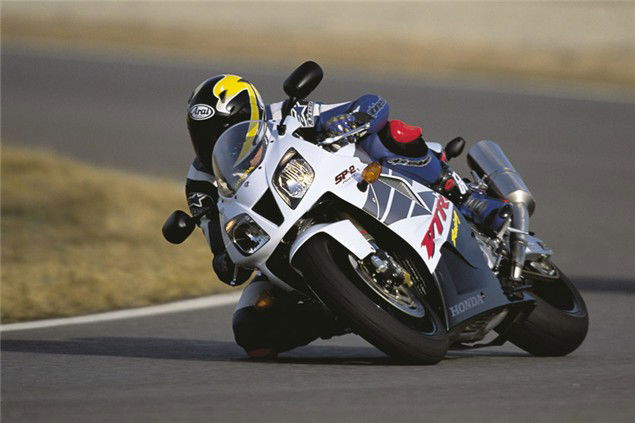First Ride: Honda VTR1000 SP-2
By winning the World Superbike Championship in 2000 in its very first year of production, you could argue that Honda’s SP-1 doesn’t have much to prove. But race development waits for no man, and so for 2002 we’ve got the SP-2.

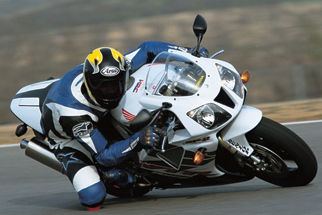 |
Right, let’s not mess around here. The biggest differences between the production SP-1 and SP-2 are the massive new injector throttle bodies (up from 54mm to 62mm) and a fancy-pants HRC-developed swingarm. Since the only two real issues with the SP-1 were its sudden (read: snatchy) throttle response when trying to roll on the throttle, and a rear end that was nigh on impossible to set-up properly (it was seemingly too hard or too soft, with no middle-ground anywhere), on the press release at least, it looks like Honda have done the right things on the SP-2 to get it flying.
The World Launch was held at Almeria circuit in the South of Spain. It’s Spain’s newest track, and is a tricky little bastard of a thing. Not so little, either, with a kilometre-long back straight, a left-hander that goes on forever, any number of technical corners and an evil right-hander that I went headfirst into the gravel at last time I was here. Naturally, on that occasion I went away from Almeria a beaten man. If the SP-2 was to get me around the track with any degree of confidence, it would have to be pretty damn good.
It certainly looks saucy in its new white livery. As part of the sales package, Honda are giving every SP-2 customer (800 bikes have been allotted to the UK) a full WSB Paddock pass for the year, which is a wicked sales promo, and a Castrol Honda sticker kit to customize your SP-2 for that genuine just-out-the-Colin-Edwards-salon look. Whether you think it actually adds much to the bike’s livery is a question of personal taste, but it’s nice to have the option.
Filtering out onto Almeria’s twisty gradients, straight away there’s the feeling of total rigidity from the SP-2 that was so familiar on the SP-1 (I ran one for a year as a longterm testbike in 2000). You’re right over the front on the SP-2, and the feedback from the Showa forks is instant and direct. Not unlike a Ducati 748R, the front of the SP-2 dominates the feeling of the whole bike and in corners you feel as though you could just lean and lean until you fell off. Which undoubtedly you could if you really fancied. However, unlike the model it supercedes, the SP-2 has a far more positive feel from the back end. I can’t comment on the Honda’s behaviour on the road because we didn’t ride it there, but on the circuit you could feel the rear Dunlop squat down and grip on the way out of corners where there was always a remarkably dead feel from the SP-1. The rear shock has modified internals while the new HRC swingarm extends the wheelbase 10mm to 1,420mm. The SP-2 certainly isn’t the quickest-turning bike on the market – infact, it took a considerable effort to turn it into Almeria’s stop-go chicane – but mid-corner poise and grip exiting those corners is now considerably improved over the SP-1.
The engine revs marginally quicker and harder than the SP-1. Honda are claiming only an extra 4bhp from their fuel injector tweaks, but the SP-2 is disarmingly fast everywhere. Fastest I saw on the back straight was 155mph and still pulling hard, but while the SP is nowhere near as quick as, say, a GSX-R1000, it revs like buggery for a big twin and fair launches itself out of corners. Quick technical highlight for you here: not only are the injector bodies bigger, but Honda have seen fit to increase the total number of fuel jets from four to 12, meaning the atomisation of petrol/air mixture is much finer and more accurate. You may find this fact boring on paper, but the result in the flesh is that you can now roll the power on evenly on the way out of corners or snap it back in for maximum effect – either way, there’s no real snatchiness as before.
Honda make no bones of the fact that the SP-2 makes less midrange power than a Ducati 998, but it usefully relishes revs all the way up to 10,000rpm before you slide in the next ratio. At Almeria, there’s a whole section of three corners that was taken in second gear on the Honda. On a less frenetic V-twin motor you’d be forever bumping into the rev-limiter or see-sawing between gears in this section, but because the SP-2 allows you to rev the nuts off it deep into the redline, you could concentrate on keeping the power on and steering the damn thing as quick as possible through the bends.
It’s a very compact motorcycle, is an SP-2, but the tall screen that came as an optional extra on the SP-1 is now standard fitment. Long ‘uns will find the distance between the seat and pegs pretty cramped and the firm suspension isn’t the most relaxing thing out on the open road, but anyone buying an SP-2 for its practical road manners is certainly shopping in the wrong mall. There is no way you’d ever do a stint as pillion on the back of an SP – I saw a wife on the back of her husband’s SP-1 in Boxhill once, and the poor woman looked bloody ridiculous with her knees somewhere up by her arsehole – and those 62mm throttle bodies guzzle down the gasoline. But that’s the price you pay for spunky V-twin performance.
The digital dash is sheer brilliance. The rev-counter is a horizontal Stack-style device, with LCD blocks running from left to right as you rev it, and a big LCD speedo to the side of that. It’s an absolute pleasure to have your nose buried in the clocks, listening to the ram-fed airbox underneath you snarling away and watching the digital tacho climbing the scales, ready to pop in the next gear on the (very positive) gearbox. Talking of the transmission, the clutch is light and being a slipper-clutch, you can nail it down on the way into corners without fear of the back end locking-up and wagging around like an over-eager black labrador.
Overall, the SP-2 is a decent development on the bike it replaces. The two main criticisms of the earlier model have been recognised and acted upon, and Honda have also made the SP-2 more race-worthy for those who’ll be taking it straight onto the track. The race-kit SP-2 racebike was also at Almeria, there being tested by World Supersport 600 racer John McGuiness and Ron Haslam. Initial reports were that it’s considerably closer to the World Superbike racer and better than the ill-fated SP-1 kit racebike, which didn’t achieve anything on any circuit, anywhere.
The personal touches such as the sticker kit, letter from Colin Edwards, personally signed poster and season-long WSB paddock pass are excellent touches on the SP-2 package, that will make every customer feel a bit unique and special. And at £10,349 on the road, anyone wanting a genuine World Superbike homologation production bike will find the SP-2 a deeply satisfying – and pleasingly rare – sportsbike on the road.
VERDICT
A worthy evolution of the SP-1. Throttle response is far better, and the chassis more precise than before. Bloody smart in its white livery, and likely to be fairly rare on the road.
EVOLUTION
2000: SP-1 appears on the scene. Long-rumoured, Honda’s ‘Ducati Beater’ is the real deal and promptly goes on to win the World Superbike Championship that year. Production bikes are maligned by very on-offy throttle response that makes feeding in the power smoothly quite tricky. Comes in red only
RIVALS
Ducati 996
- More midrange than the SP-1, legendary styling, few concessions to road comfort and expensive to maintain
Aprilia RSV1000
- The best-selling V-twin superbike in Europe. Slightly tinny motor and ‘big bike’ feel more than compensated for by attention to detail, excellent handling and everyday useability
SPECS
TYPE - SUPERSPORTS
PRODUCTION DATE - 2002
PRICE NEW - £10,349
ENGINE CAPACITY - 999cc
POWER - 138bhp@10,000rpm
TORQUE - 77ft.lb@8,000rpm
WEIGHT - 194kg
SEAT HEIGHT - 820mm
FUEL CAPACITY - N/A
TOP SPEED - N/A
0-60 - n/a
TANK RANGE - N/A
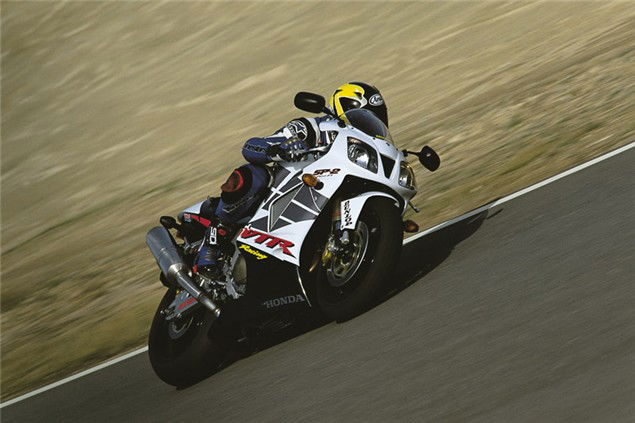
Right, let’s not mess around here. The biggest differences between the production SP-1 and SP-2 are the massive new injector throttle bodies (up from 54mm to 62mm) and a fancy-pants HRC-developed swingarm. Since the only two real issues with the SP-1 were its sudden (read: snatchy) throttle response when trying to roll on the throttle, and a rear end that was nigh on impossible to set-up properly (it was seemingly too hard or too soft, with no middle-ground anywhere), on the press release at least, it looks like Honda have done the right things on the SP-2 to get it flying.
The World Launch was held at Almeria circuit in the South of Spain. It’s Spain’s newest track, and is a tricky little bastard of a thing. Not so little, either, with a kilometre-long back straight, a left-hander that goes on forever, any number of technical corners and an evil right-hander that I went headfirst into the gravel at last time I was here. Naturally, on that occasion I went away from Almeria a beaten man. If the SP-2 was to get me around the track with any degree of confidence, it would have to be pretty damn good.
It certainly looks saucy in its new white livery. As part of the sales package, Honda are giving every SP-2 customer (800 bikes have been allotted to the UK) a full WSB Paddock pass for the year, which is a wicked sales promo, and a Castrol Honda sticker kit to customize your SP-2 for that genuine just-out-the-Colin-Edwards-salon look. Whether you think it actually adds much to the bike’s livery is a question of personal taste, but it’s nice to have the option.
Filtering out onto Almeria’s twisty gradients, straight away there’s the feeling of total rigidity from the SP-2 that was so familiar on the SP-1 (I ran one for a year as a longterm testbike in 2000). You’re right over the front on the SP-2, and the feedback from the Showa forks is instant and direct. Not unlike a Ducati 748R, the front of the SP-2 dominates the feeling of the whole bike and in corners you feel as though you could just lean and lean until you fell off. Which undoubtedly you could if you really fancied. However, unlike the model it supercedes, the SP-2 has a far more positive feel from the back end.
I can’t comment on the Honda’s behaviour on the road because we didn’t ride it there, but on the circuit you could feel the rear Dunlop squat down and grip on the way out of corners where there was always a remarkably dead feel from the SP-1. The rear shock has modified internals while the new HRC swingarm extends the wheelbase 10mm to 1,420mm. The SP-2 certainly isn’t the quickest-turning bike on the market – infact, it took a considerable effort to turn it into Almeria’s stop-go chicane – but mid-corner poise and grip exiting those corners is now considerably improved over the SP-1.
Honda VTR1000 SP-2 Information
Evolution
2000: SP-1 appears on the scene. Long-rumoured, Honda’s ‘Ducati Beater’ is the real deal and promptly goes on to win the World Superbike Championship that year. Production bikes are maligned by very on-offy throttle response that makes feeding in the power smoothly quite tricky. Comes in red only
Rivals
- Ducati 996
More midrange than the SP-1, legendary styling, few concessions to road comfort and expensive to maintain
- Aprilia RSV1000
The best-selling V-twin superbike in Europe. Slightly tinny motor and ‘big bike’ feel more than compensated for by attention to detail, excellent handling and everyday useability
The engine revs marginally quicker and harder than the SP-1. Honda are claiming only an extra 4bhp from their fuel injector tweaks, but the SP-2 is disarmingly fast everywhere. Fastest I saw on the back straight was 155mph and still pulling hard, but while the SP is nowhere near as quick as, say, a GSX-R1000, it revs like buggery for a big twin and fair launches itself out of corners. Quick technical highlight for you here: not only are the injector bodies bigger, but Honda have seen fit to increase the total number of fuel jets from four to 12, meaning the atomisation of petrol/air mixture is much finer and more accurate. You may find this fact boring on paper, but the result in the flesh is that you can now roll the power on evenly on the way out of corners or snap it back in for maximum effect – either way, there’s no real snatchiness as before.
Honda make no bones of the fact that the SP-2 makes less midrange power than a Ducati 998, but it usefully relishes revs all the way up to 10,000rpm before you slide in the next ratio. At Almeria, there’s a whole section of three corners that was taken in second gear on the Honda. On a less frenetic V-twin motor you’d be forever bumping into the rev-limiter or see-sawing between gears in this section, but because the SP-2 allows you to rev the nuts off it deep into the redline, you could concentrate on keeping the power on and steering the damn thing as quick as possible through the bends.
It’s a very compact motorcycle, is an SP-2, but the tall screen that came as an optional extra on the SP-1 is now standard fitment. Long ‘uns will find the distance between the seat and pegs pretty cramped and the firm suspension isn’t the most relaxing thing out on the open road, but anyone buying an SP-2 for its practical road manners is certainly shopping in the wrong mall. There is no way you’d ever do a stint as pillion on the back of an SP – I saw a wife on the back of her husband’s SP-1 in Boxhill once, and the poor woman looked bloody ridiculous with her knees somewhere up by her arsehole – and those 62mm throttle bodies guzzle down the gasoline. But that’s the price you pay for spunky V-twin performance.
The digital dash is sheer brilliance. The rev-counter is a horizontal Stack-style device, with LCD blocks running from left to right as you rev it, and a big LCD speedo to the side of that. It’s an absolute pleasure to have your nose buried in the clocks, listening to the ram-fed airbox underneath you snarling away and watching the digital tacho climbing the scales, ready to pop in the next gear on the (very positive) gearbox. Talking of the transmission, the clutch is light and being a slipper-clutch, you can nail it down on the way into corners without fear of the back end locking-up and wagging around like an over-eager black labrador.
Overall, the SP-2 is a decent development on the bike it replaces. The two main criticisms of the earlier model have been recognised and acted upon, and Honda have also made the SP-2 more race-worthy for those who’ll be taking it straight onto the track. The race-kit SP-2 racebike was also at Almeria, there being tested by World Supersport 600 racer John McGuiness and Ron Haslam. Initial reports were that it’s considerably closer to the World Superbike racer and better than the ill-fated SP-1 kit racebike, which didn’t achieve anything on any circuit, anywhere.
The personal touches such as the sticker kit, letter from Colin Edwards, personally signed poster and season-long WSB paddock pass are excellent touches on the SP-2 package, that will make every customer feel a bit unique and special. And at £10,349 on the road, anyone wanting a genuine World Superbike homologation production bike will find the SP-2 a deeply satisfying – and pleasingly rare – sportsbike on the road.
Verdict
A worthy evolution of the SP-1. Throttle response is far better, and the chassis more precise than before. Bloody smart in its white livery, and likely to be fairly rare on the road.
Honda VTR1000 SP2 Specs
PRICE NEW - £10,349
ENGINE CAPACITY - 999cc
POWER - 138bhp@10,000rpm
TORQUE - 77ft.lb@8,000rpm
WEIGHT - 194kg
SEAT HEIGHT - 820mm
